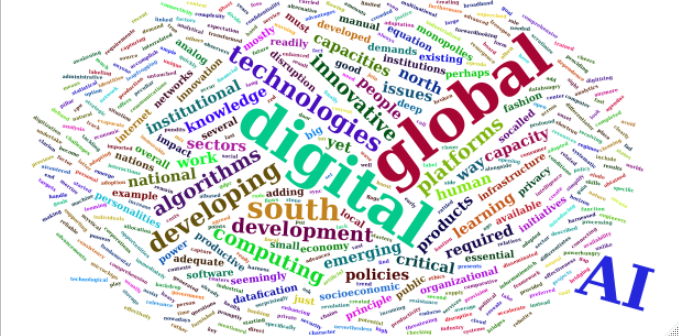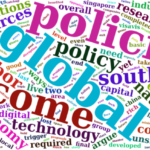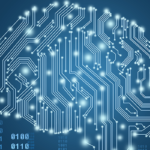The current long wave of digital innovation has finally broken the last bastion of socio-economic resistance. While early advances transformed communications infrastructure and enhanced consumer interactions, the resurgence of Artificial Intelligence (AI) and all its relatives, alongside new technologies such as blockchains, have rattled seemingly immovable sectors of the economy thus opening the door for the global disruption of productive and financial processes.  Not surprisingly, observers and pundits have quickly agreed on a label for such disruption, the 4th Industrial Revolution (4IR) that could have a profound impact on countries, institutions and people. No stone will remain untouched, such is the warning.
Not surprisingly, observers and pundits have quickly agreed on a label for such disruption, the 4th Industrial Revolution (4IR) that could have a profound impact on countries, institutions and people. No stone will remain untouched, such is the warning.
AI in the Global South
Countries in the Global South find themselves in a peculiar situation. For starters, most if not all emerging digital technologies are products of so-called industrialized countries. They thus need to be imported, adopted and adapted to local contexts. While not unique to digital technologies, that demands the allocation of fiscal and human resources – not always readily available. On the other hand, the adoption and adaptation of incoming technologies also create new opportunities to harness them in sync with local conditions while enhancing overall human development.
Second, introducing AI in productive sectors will increase productivity, simplify global supply chains and reduce production costs across the board. As a result, existing economic comparative advantages of developing countries might evaporate in the short-run, thus adding future of work related issues into an already crowded development agenda. The expectation is that the 4IR will also have a deep impact on the service sector as well as on the way overall knowledge is generated and disseminated.
The AI-based provision of information-rich public and private services such as health, education, justice, and banking is data-hungry and demands the systematic capture of vast amounts of data from individuals. Issues of privacy, security, confidentiality and ethics immediately emerge as red flags. Tackling these issues from the onset is essential and offers the potential of leap-frogging the Global North by adopting innovative and forward-looking AI, data and privacy policies, among several others.
Datafication started over 15 years ago, promptly receiving a critical boost from emerging social networks. Personal and public data (including that from government institutions) has since been flowing from the Global South to the Global North, specifically into a small set of large multinational corporations perhaps best described as digital monopolies. These data flows also occur within the Global North. Neverthesless, what differentiates developing countries is the lack of adequate institutional and organizational capacities to endorse and promote alternative regimes that put people at the center of the equation – the EU GDPR being a good albeit limited example on the side of developed nations. Another differentiator is the so-called digital divide, still ample in the Global South. Most people in developing nations have yet to join the global digital network. Datafication is still looming on the horizon for them.
Against this backdrop, AI is now starting to gain track in the Global South, threatening to add new socio-economic and political challenges to the mix if not harnessed in a strategic and innovative fashion. How to accomplish that is thus one of the fundamental questions for developing countries.
Analytical Framework
At first sight, AI presents itself in the form of advanced computer algorithms that mostly elude the comprehension of the average person. Furthermore, AI has several interrelated personalities that take the identities of Machine Learning (ML), Neural Networks (NN) and Deep Learning (DL) – the latter being perhaps the most disruptive and innovative of all, adding even more complexity to its seemingly mystical nature.
As just software, connecting AI with Free/Open Source software (FOSS) is natural as many of the existing AI platforms are readily available on the Internet. In principle, anyone can toy with such open platforms provided they possess the required knowledge and skills – a big ask for many developing countries. Many of these are furnished by the digital monopolies mentioned above.
However, a closer look reveals the true character of AI and its heavy dependence on other factors. They include:
- Big data. While not required by all AI personalities, the effectiveness of most innovative ML and DL algorithms is a direct function of the data points they can scrutinize. The more, the merrier. Small data is not an option here.
- Data analytics. Digital platforms that assist in data capturing, analysis and consistency checking and the statistical relevance of results obtained by AI algorithms must be in place. Data cleaning is also a critical factor usually completed in a manual fashion. Manual AI data labeling has become an industry itself, mostly supporting supervised learning initiatives. Ghost work is an emerging trend here.
- Computing power. AI algorithms are power-hungry and thus demand high CPU capacity. In fact, AI-centered microchips are now being developed to accelerate computing power and reduce processing time.
- Digital Infrastructure. Data centers with adequate storage and computing capacity are part of the equation. Cloud computing platforms are nowadays the preferred way to handle these requirements, also providing much needed secure, reliable and fast (broadband) Internet connectivity.
- Capacity. The availability of human and institutional capacities to undertake comprehensive AI projects and initiatives is critical. While AI trained engineers are key, administrative and organizational capacities are also required to ensure the work is carried out within a specific institutional context and has clearly defined goals and targets.
- Policy. The development of national AI policies is yet another essential pillar. In principle, these policies should be linked to both development agendas and national innovation systems. National states thus have a role to play too.
AI is thus more than just another technological fad. Instead, AI effectively bridges the gap between the digital and analog worlds by making digitization a means to an end – unlike previous digital technologies. Creating new digital products is not the goal anymore. Rather, digitizing the way analog products and knowledge are created is the clarion call. The recent robotics advancements in many sectors of the economy is a good example of such bridging.
And the Global South must be ready to avoid yet another rude awakening.
Cheers, Raúl





